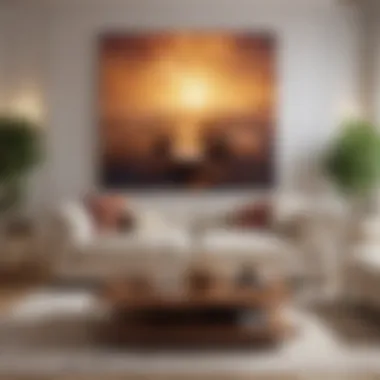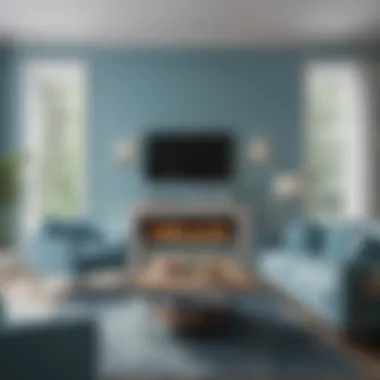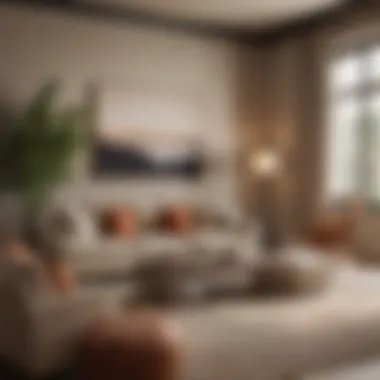Unveiling the Influence of Calming Living Room Colors on Serenity and Well-being


Outdoor Decor Ideas
The choice of colors in interior design plays a crucial role in shaping the ambiance of a living room. When seeking to create a tranquil and serene environment for relaxation, it is imperative to carefully select calming color palettes that promote a sense of peace and well-being. Understanding the psychological effects of different hues can significantly impact the overall mood and atmosphere of the space. By exploring various color combinations and their corresponding emotional influences, one can curate a living room that exudes tranquility and harmony.
Seasonal Inspirations
Seasons inspire a spectrum of colors that can be integrated into the living room to evoke a particular mood or theme. For instance, soft pastel shades like light blues and pale greens can instill a sense of freshness and renewal, ideal for spring-inspired decor. Warm earthy tones such as terracottas and deep browns are reminiscent of fall hues, creating a cozy and inviting atmosphere in the colder months. By adapting the color scheme to reflect the season, one can enhance the overall ambiance of the living room and create a harmonious connection with nature.
Furniture Selection
In addition to choosing the right color palette, furniture selection plays a significant role in establishing a calming environment in the living room. Opting for pieces made from natural materials such as wood or rattan can introduce a sense of warmth and authenticity to the space. Soft, plush upholstery in neutral tones like creams or beiges can complement soothing color schemes, adding comfort and elegance to the room. By carefully curating furniture that aligns with the desired ambiance, one can create a harmonious and inviting living space that promotes relaxation and well-being.
Decorative Lighting
Lighting is an essential element in creating a serene living room ambiance. Soft, diffused lighting can help to create a sense of warmth and coziness, ideal for relaxation and unwinding after a long day. Decorative lighting fixtures such as pendant lights or LED strips can add a touch of sophistication and style to the room while contributing to the overall mood. By strategically placing lighting elements throughout the space and incorporating dimmable options, one can enhance the calming atmosphere of the living room and create a soothing environment for relaxation.
Plant Arrangements
Bringing elements of nature into the living room through plant arrangements can further enhance the calming ambiance of the space. Lush greenery and botanical accents can introduce a sense of tranquility and vitality, promoting a connection with the outdoors. Choosing low-maintenance plants such as succulents or peace lilies can add a touch of greenery without overwhelming the room. By strategically placing plants in key areas and selecting pots that complement the overall decor, one can create a refreshing and serene living room environment that revitalizes the senses.
Hardscaping Solutions
Incorporating hardscaping elements such as stone features or concrete accents can add a touch of industrial chic to the living room while maintaining a calming ambiance. Stone veneers or exposed brick walls can introduce texture and visual interest to the space, creating a unique focal point. Pairing these hardscaping solutions with soft furnishings and organic accents can strike a balance between raw materials and comfort, resulting in a harmonious and serene living room design.
Sustainable Practices
Embracing sustainable design practices in the living room can not only create a calming environment but also contribute to a more eco-friendly lifestyle. Opting for eco-conscious materials such as reclaimed wood or recycled glass can reduce the carbon footprint of the space while adding character and charm. Installing energy-efficient lighting fixtures and appliances can lower energy consumption and promote environmental responsibility. By integrating sustainable practices into the design process, one can create a peaceful and eco-conscious living room that prioritizes well-being and sustainability.
Introduction
As we navigate through the intricacies of selecting colors that promote serenity and calmness, we are confronted with a myriad of considerations. The choice of hues goes beyond personal preference; it extends into the realm of color psychology, where each shade carries a unique set of associations and effects on mood. By curating a palette that harmonizes with the intended ambiance, one can cultivate a living room environment that exudes tranquility and fosters a sense of relaxation.
For the discerning individual seeking to craft a living space that embodies luxury and sophistication, the selection of calming colors plays a pivotal role. Not only do these colors reflect a refined taste and style, but they also contribute to enhancing the overall experience of dwelling in this space. From muted neutrals to soothing pastels, each color choice is a deliberate step towards curating an atmosphere that transcends the ordinary and embraces the extraordinary.
In this article, we unravel the layers of exploring calming living room colors, unraveling the complexities of color theory and interior design to provide valuable insights for luxury travel curators, high-end interior designers, fine dining consultants, luxury event planners, personal stylists, and image consultants. By examining the subtle nuances of color palettes and their impact on mood and well-being, we aim to equip our readers with the knowledge and inspiration needed to transform their living rooms into havens of tranquility and style.


Understanding the Impact of Colours
Understanding the impact of colours is crucial in the realm of interior design. Colours play a significant role in setting the ambiance and tone of a living space. In this article, we focus on how different colours can influence mood, emotions, and overall well-being in a home environment. By understanding the psychology behind colours, homeowners can create a serene and calming atmosphere that promotes relaxation and comfort.
Psychological Effects of Colours
Blue
Blue is known for its calming and soothing qualities. It is often associated with peace, tranquility, and stability. In this article, we explore how incorporating shades of blue in a living room can evoke feelings of serenity and relaxation. The coolness of blue hues can help to create a sense of spaciousness and peace, making it an ideal choice for those seeking a tranquil living space.
Green
Green symbolizes nature, growth, and harmony. When used in interior design, green can bring a sense of renewal and freshness to a room. In this article, we delve into how different tones of green can affect the overall atmosphere of a living room. From light pastel greens to deep forest greens, each shade has its own unique way of promoting a calming environment and connecting occupants with the outdoors.
Gray
Gray is often associated with sophistication, elegance, and neutrality. In this article, we discuss how incorporating shades of gray in a living room can create a sense of balance and composure. Gray provides a versatile backdrop that allows other elements in the room to stand out while maintaining a sense of calmness and relaxation. Whether used as a dominant colour or an accent, gray can contribute to a serene living room environment.
Beige
Beige is a warm and inviting neutral colour that exudes a sense of warmth and comfort. In this article, we explore the different hues of beige and their impact on the ambiance of a living room. From soft sandy beiges to rich caramel tones, beige creates a cozy and serene atmosphere that encourages relaxation and tranquility. By understanding the nuances of beige, homeowners can achieve a harmonious and welcoming living space.
Calming Color Palettes
In this article, we delve into the significance of calming color palettes in creating a tranquil living space. Calming color palettes play a crucial role in setting the ambiance of a room, influencing mood, and contributing to a sense of relaxation and peace. When selecting colors for a living room, considering calming color palettes can transform the space into a sanctuary that promotes well-being and harmony. Understanding the nuances of different color combinations allows for a thoughtful approach to interior design.
Soft Blues and Aquas
Powder Blue
Powder Blue embodies a delicate balance between soothing and elegant. This shade of blue is renowned for its calming effect on the mind, evoking a sense of serenity and clarity. The gentle nature of Powder Blue makes it a popular choice for living rooms aiming to create a peaceful atmosphere. Its subtle undertones provide a versatile palette for various design elements, harmonizing well with different textures and decor styles. Despite its soft appearance, Powder Blue adds depth and sophistication to a space, making it an ideal selection for those seeking a refined aesthetic in their living areas.
Seafoam Green
Seafoam Green brings a touch of freshness and tranquility to a room, reminiscent of serene ocean views. This hue is celebrated for its ability to infuse spaces with a sense of relaxation and rejuvenation. The lightness of Seafoam Green creates an airy and uplifting environment, perfect for brightening up living rooms and creating a sense of openness. Its versatile nature allows for seamless integration with various design elements, making it a versatile choice for those looking to evoke a coastal or nature-inspired ambiance in their living spaces.
Neutral Tones


Taupe
Taupe presents a warm and inviting option for those seeking a neutral color palette with a touch of sophistication. This versatile hue strikes a balance between gray and brown, offering a soft and refined look to living rooms. Taupe's earthy undertones bring a sense of grounding to a space, creating a cozy and welcoming atmosphere. The versatility of Taupe makes it an excellent choice for complementing different furniture styles and decor pieces, providing a timeless backdrop for various design aesthetics.
Pale Gray
Pale Gray exudes elegance and understated beauty, making it a popular choice for those desiring a chic and modern living room. The subtle warmth of Pale Gray adds depth to a space while maintaining a clean and crisp appearance. Its adaptability allows for effortless pairing with both bold and muted tones, offering endless possibilities for personalization and styling. Pale Gray's calming presence makes it an ideal option for those aiming to create a sophisticated and serene environment in their living rooms.
Earthy Hues
Sage
Sage embodies a connection to nature with its soothing and earthy qualities, reminiscent of lush greenery and natural landscapes. This calming hue infuses living rooms with a harmonious and peaceful ambiance, promoting a sense of balance and tranquility. Sage's soft and muted tones create a calming backdrop, ideal for relaxation and unwinding after a long day. Its organic appeal makes it a popular choice for those seeking to bring elements of the outdoors into their interior spaces, fostering a connection with nature within the comfort of their homes.
Terracotta
Terracotta introduces warmth and richness to living rooms, adding a touch of earthy charm and character to the space. This timeless hue exudes a sense of coziness and comfort, evoking the feeling of being embraced by natural terracotta elements. The rustic allure of Terracotta brings a unique depth to a room, creating a warm and welcoming environment. Its versatility allows for creative styling and layering, making it an excellent choice for those looking to infuse their living rooms with a blend of tradition and modernity, creating a space that is both inviting and aesthetically pleasing.
Implementing Color in Living Room Design
Implementing Color in Living Room Design is a pivotal aspect of creating a serene and welcoming living space. Selecting the appropriate hues and tones can significantly influence the overall ambiance of the room, setting the tone for relaxation and comfort. By strategically incorporating colors into the design scheme, you can enhance the visual appeal of the living room while promoting a sense of tranquility and well-being.
When considering Implementing Color in Living Room Design, it is essential to pay attention to both the primary wall color and accent walls. The wall color serves as the backdrop for the entire room, influencing the perception of space and light. Whether opting for soothing neutrals or calming pastels, the choice of wall color lays the foundation for the room's aesthetic.
Wall Color
Accent Walls
Accent walls play a crucial role in Implementing Color in Living Room Design by adding visual interest and dimension to the space. Opting to paint or decorate one wall in a contrasting color or texture can create a focal point, drawing attention to a specific area or architectural feature within the room. This technique can help break the monotony of a single-color scheme while injecting personality and style into the space.
Accent walls offer versatility in design, allowing homeowners to experiment with bold color choices or unique finishes without overwhelming the entire room. Whether utilizing a vibrant accent color to highlight a fireplace or incorporating a textured wall covering to add depth, accent walls can transform the living room into a dynamic and engaging environment.
Overall Color Scheme
The overall color scheme is a fundamental component of Implementing Color in Living Room Design, as it dictates the mood and atmosphere of the space. Consistency in color palette promotes harmony and cohesion throughout the room, ensuring a unified and polished look. Whether opting for a monochromatic theme or a complementary color scheme, the overall color scheme sets the tone for the room's aesthetic and should align with the desired ambiance.
Creating a cohesive color scheme involves selecting colors that complement each other while considering factors such as natural light exposure and room size. Harmonizing wall color, furniture upholstery, and decor accessories can create a visually pleasing environment that fosters relaxation and comfort. Careful attention to the overall color scheme is essential in achieving a balanced and inviting living room design.


In the realm of interior design, the topic of Accessorizing for Harmony holds a crucial position, especially when creating a serene living room environment. Accessorizing plays a significant role in tying together various elements of the room, bringing cohesion and a sense of completeness. By carefully selecting furniture and decor pieces that complement each other, a harmonious atmosphere can be achieved. The choice of accessories can accentuate the chosen color palettes, enhancing the overall calming effect desired in the living space. Furthermore, thoughtful accessorizing can elevate the visual appeal of the room, making it more inviting and comfortable for inhabitants and guests alike.
Furniture and Decor: Complementary Textures
Within the domain of furniture and decor, the consideration of Complementary Textures is paramount to achieving the desired aesthetic and ambience. Complementary textures refer to the juxtaposition of different tactile surfaces that work harmoniously to create visual interest and depth. In the context of this article, selecting furniture and decor pieces with complementary textures can add richness and sophistication to the living room design, enhancing the calming atmosphere sought after. The key characteristic of complementary textures lies in their ability to create a dynamic interplay between various materials, such as smooth woods paired with soft fabrics or sleek metal finishes against plush upholstery. This juxtaposition not only adds a layer of complexity to the room but also offers a sensory experience that is both visually stimulating and tactually pleasing. The unique feature of complementary textures is their versatility; they can effortlessly blend with different design styles, from contemporary to classic, making them a popular choice for those looking to infuse elegance and depth into their living spaces.
Furniture and Decor: Subdued Patterns
When considering Subdued Patterns in furniture and decor selection, one acknowledges their significant contribution to the overall goal of creating a serene living room environment. Subdued patterns entail designs that are understated, muted, and gentle on the eye, offering a sense of tranquility and sophistication to the space. In the context of this article, the incorporation of subdued patterns brings a nuanced visual interest without overwhelming the room's calming vibe. The key characteristic of subdued patterns is their ability to add dimension and personality to furniture and decor items without being too visually distracting. This quality makes subdued patterns a beneficial choice for those aiming to create a subtle yet refined ambiance in their living rooms. An advantage of subdued patterns is their versatility; they can seamlessly blend with various color palettes and design themes, offering flexibility and longevity in interior styling. It is essential to note that while subdued patterns can add depth and elegance to a space, overusing them may lead to visual clutter and detract from the desired serene atmosphere, making their strategic placement and balance crucial in achieving a harmonious living room design.
Section 5: Lighting Considerations
In the realm of interior design, the significance of lighting considerations cannot be underestimated. When crafting a serene living room environment, the choice of lighting plays a pivotal role in setting the mood and ambiance of the space. Proper illumination can enhance the colors of the room, elevate textures, and create a cozy atmosphere. One must carefully evaluate various elements of lighting considerations such as the positioning of light fixtures, the type of bulbs used, and the intensity of light to achieve the desired effect. By orchestrating lighting elements effectively, one can transform a room into a tranquil sanctuary that promotes relaxation and well-being.
Section 5: Natural Light
Within the realm of natural light, maximizing daylight stands out as an essential aspect when designing a calming living room. Maximizing daylight has a profound impact on the overall ambiance of a space, infusing it with warmth and vitality. The key characteristic of maximizing daylight lies in its ability to create a sense of spaciousness and airiness within a room, contributing to a refreshing and revitalizing environment. By harnessing the natural brilliance of sunlight, one can reduce the reliance on artificial lighting sources, thus minimizing energy consumption and embracing eco-friendliness. The unique feature of maximizing daylight lies in its ability to shift throughout the day, casting dynamic patterns and shadows that animate the living space. This natural play of light not only adds visual interest but also positively influences one's mood and well-being, making it a popular choice among designers aiming to create harmonious interiors that seamlessly blend with the outdoors.
Effects on Mood and Well-Being
In the cosmic interplay of interior design, where colors orchestrate the symphony of ambiance, the segment on Effects on Mood and Well-Being emerges as a crucial movement. At its core lies the fundamental understanding that hues do not just paint walls; they shape emotions, influence psychology, and sculpt atmospheres. This article delves deep into the psychological nuances of colors and their profound impact on the human psyche, particularly in the realm of creating tranquil living spaces that nurture relaxation and foster well-being.
Beyond the mere aesthetic appeal, the selection of calming living room colors goes beyond the visual realm. It transcends into a realm where subtle shades and nuanced tones have the power to soothe, rejuvenate, and restore. Understanding the effects of different colors on emotions and mindset forms the cornerstone of crafting a living room that acts as a sanctuary, radiating tranquility and calmness. By elucidating the intricate connections between colors and moods, this section aims to empower readers to wield the palette as a tool for enhancing mental and emotional wellness.
Delving deeper into the intrinsic relationship between colors and emotions opens avenues of exploration into the world of interior design that go beyond surface decor to touch the essence of human experience. By delving into the profound impacts of colors on mental states, this article invites readers to embark on a journey of creating living spaces that not only please the eye but also nurture the soul, elevating the concept of home to a realm of holistic well-being and serene refuge.
Enhancing Relaxation
Creating a Sanctuary
As we navigate the bustling currents of modern life, the concept of 'Creating a Sanctuary' within the living room emerges as an oasis of calm amid the chaos. This subsection delves into the tailored selection of elements and colors that amalgamate to form a cocoon of tranquility within the home. 'Creating a Sanctuary' encapsulates the essence of bringing spa-like serenity and relaxation into the living space, emphasizing the need for a designated area that fosters peace and inner tranquility.
A key characteristic of 'Creating a Sanctuary' lies in its ability to create a serene retreat within the confines of one's living room. By incorporating elements such as plush rugs, soft lighting, and nature-inspired hues, this concept transforms a mere living space into a haven for relaxation, rejuvenation, and contemplation. The beauty of a sanctuary lies not only in its visual aesthetics but also in its ability to evoke a sense of peacefulness and harmony, offering a respite from the demands of the external world.
The unique feature of 'Creating a Sanctuary' lies in its multidimensional approach to relaxation. By curating a space that prioritizes comfort, sensory indulgence, and visual harmony, this concept ensures that every corner of the living room resonates with a tranquil ambiance. While the advantages of 'Creating a Sanctuary' lie in its ability to promote mental clarity, reduce stress, and enhance overall well-being, it behooves individuals to strike a balance between luxury and simplicity to create a space that truly encapsulates the essence of relaxation within the overarching goal of this article.
Conclusion
In contemplating the relevance of this topic within the context of our article, it becomes evident that the choice of colors goes beyond mere aesthetics; it serves as a powerful tool for curating a harmonious environment that caters to both physical comfort and emotional respite. By immersing oneself in soft blues and aquas such as powder blue and seafoam green, or embracing the warmth of neutral tones like taupe and pale gray, one can create a sanctuary that nurtures the senses and promotes a sense of peace within the confines of home.
Moreover, understanding how to implement these calming color palettes into living room design, whether through accent walls or an overall color scheme, equips individuals with the knowledge needed to transform their spaces into reflections of tranquility and sophistication. The art of accessorizing with furniture and decor that complement these soothing colors further elevates the ambiance, infusing the room with a sense of cohesion and balance.
In the broader spectrum of interior design, lighting considerations also come into play, with a focus on maximizing natural light to enhance the calming effects of chosen color schemes. This holistic approach to designing a serene living room underscores the interconnectedness of elements such as color, light, and texture in shaping our everyday experiences and influencing our mental well-being.







